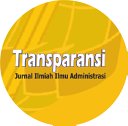Literatur Review : Faktor yang Mempengaruhi Kualitas Layanan Kereta Cepat Jakarta-Bandung (KCJB)
DOI:
https://doi.org/10.31334/transparansi.v8i1.4233Keywords:
Kereta Cepat, KCJB, Tingkat Kepuasan, Penumpang, High Speed Train, Level of Satisfaction Passenger,Abstract
(A Review: Factors Affecting the Quality Services of Jakarta-Bandung High-Speed Train) The construction of the Jakarta-Bandung High-Speed Train (HST) project is a national strategic project that has a very large impact on economic development in Indonesia. Currently, the HST passenger target has not met the target desired by the Operator or the regulator, the community has not switched from the initial mode of transportation to using HST, so it is necessary to map what factors cause passengers or the community to choose HST compared to other modes. This study aims to map the factors that influence the level of satisfaction of HST passengers. Through literature studies and reviews of previous references, this study will present factors and variables that are considered to influence the level of satisfaction of HST passengers. The results of the literature study will be validated by experts through Focus Group Discussions (FGD) so that the factors and variables that are considered to influence can be used. This research can be utilized by operators and regulators who will increase the level of passengers satisfaction so that the number of HST passengers increases over time and meets the target. Abstrak Pembangunan proyek Kereta Cepat Jakarta-Bandung (KCJB) merupakan proyek strategis nasional yang membawa dampak yang sangat besar pada perkembangan perekonomian di Indonesia. Saat ini target penumpang KCJB belum memenuhi target yang diinginkan oleh Operator maupun dari regulator, masyarakat belum mengalihkan moda transportasi dari moda awal menjadi menggunakan KCJB, sehingga perlu dipetakan faktor apa yang menyebabkan penumpang atau masyarakat dapat memilik KCJB dibandingkan dengan moda lain. Penelitian ini bertujuan untuk memetakan faktor yang mempengaruhi tingkat kepuasan penumpang KCJB. Melalui studi literatur dan telaah dari referensi terdahulu penelitian ini akan menyajikan faktor dan variabel yang dianggap mempengaruhi tingkat kepuasaan pengguna KCJB. Hasil dari studi literatur akan divalidasi oleh pakar melalui Focus Group Discussion (FGD) sehingga faktor dan variabel yang dianggap mempengaruhi dapat digunakan. Penelitian ini akan dapat dimanfaatkan oleh operator dan regulator yang akan meningkatkan tingkat kepuasan pengguna agar jumlah penumpang KCJB meningkat dari waktu ke waktu dan memenuhi target.References
O. Fröidh, “Perspectives for a future high-speed train in the Swedish domestic travel market,†J Transp Geogr, vol. 16, no. 4, pp. 268–277, Jul. 2008, doi: 10.1016/j.jtrangeo.2007.09.005.
N. L. Williams, N. Ferdinand, and B. Pasian, “Online Stakeholder Interactions in the Early Stage of a Megaproject,†Project Management Journal, vol. 46, no. 6, pp. 92–110, Dec. 2016, doi: 10.1002/pmj.21548.
E. D. Blas Luis Perez Henriquez, “High-Speed Rail and Sustainability,†2017.
V. Yilmaz and E. Ari, “The effects of service quality, image, and customer satisfaction on customer complaints and loyalty in high-speed rail service in Turkey: a proposal of the structural equation model,†Transportmetrica A: Transport Science, vol. 13, no. 1, pp. 67–90, Jan. 2017, doi: 10.1080/23249935.2016.1209255.
B. Deal, J. Hong Kim, and A. Chakraborty, “Growth Management and Sustainable Transport Growth Management and Sustainable Transport: Do Growth Management Policies Promote Transit Use?,†2009.
M. Friman and O. A. Budiono, “Title CUSTOMER SATISFACTION IN PUBLIC BUS TRANSPORT-A study of travelers’ perception in Indonesia,†2009.
M. Friman and M. Fellesson, “Service Supply and Customer Satisfaction in Public Transportation Service Supply and Customer Satisfaction in Public Transportation: The Quality Paradox,†2009. [Online]. Available: http://BEST2005.net/
B. Suryawardani and A. Wulandari, “Determinant Factors of Customers Switching Behavior to Customer Satisfaction and Loyalty in Online Transportation Users in Bandung,†Jurnal Dinamika Manajemen, vol. 11, no. 1, pp. 12–26, Mar. 2020, doi: 10.15294/jdm.v11i1.21432.
A. Widjaja, W. Astuti, and A. Manan, “The Relationship between Customer Satisfaction and Loyalty: Evidence on Online Transportation Services in Indonesia,†International Journal of Advances in Scientific Research and Engineering, vol. 5, no. 4, pp. 214–222, 2019, doi: 10.31695/ijasre.2019.33166.
J. De Oña and R. De Oña, “Quality of service in public transport based on customer satisfaction surveys: A review and assessment of methodological approaches,†Transportation Science, vol. 49, no. 3, pp. 605–622, Aug. 2015, doi: 10.1287/trsc.2014.0544.
D. Alleman, A. Antoine, D. D. Gransberg, and K. R. Molenaar, “Comparison of qualifications-based selection and best-value procurement for construction manager-general contractor highway construction,†Transp Res Rec, vol. 2630, pp. 59–67, 2017, doi: 10.3141/2630-08.
D. Tran, K. R. Molenaar, and D. D. Gransberg, “Implementing best-value procurement for design-bid-build highway projects,†Transp Res Rec, vol. 2573, pp. 26–33, 2016, doi: 10.3141/2573-04.
J. S. Chou, C. Kim, Y. C. Kuo, and N. C. Ou, “Deploying effective service strategy in the operations stage of high-speed rail,†Transp Res E Logist Transp Rev, vol. 47, no. 4, pp. 507–519, 2011, doi: 10.1016/j.tre.2010.12.004.
F. Nurprihatin, Y. B. Kurniawan, and G. D. Rembulan, “MEASURING PASSENGER SATISFACTION LEVEL USING GAP SCORE ANALYSIS AND IMPORTANCE PERFORMANCE ANALYSIS AT TRAIN STATION,†JIEMS (Journal of Industrial Engineering and Management Systems), vol. 15, no. 2, Oct. 2022, doi: 10.30813/jiems.v15i2.3800.
M. A. Abbasi-Moghaddam, E. Zarei, R. Bagherzadeh, H. Dargahi, and P. Farrokhi, “Evaluation of service quality from patients’ viewpoint,†BMC Health Serv Res, vol. 19, no. 1, Mar. 2019, doi: 10.1186/s12913-019-3998-0.
M. Pinto Nunez, C. Lopez Del Puerto, and H. D. Jeong, “Development of a Partnering Maturity Assessment Tool for Transportation Agencies,†Journal of Legal Affairs and Dispute Resolution in Engineering and Construction, vol. 10, no. 4, Nov. 2018, doi: 10.1061/(asce)la.1943-4170.0000272.
J. Minser and V. Webb, “Quantifying the benefits: Application of customer loyalty modeling in public transportation context,†Transp Res Rec, no. 2144, pp. 111–120, Jan. 2010, doi: 10.3141/2144-13.
J. S. Chou and C. Kim, “A structural equation analysis of the QSL relationship with passenger riding experience on high speed rail: An empirical study of Taiwan and Korea,†Expert Syst Appl, vol. 36, no. 3 PART 2, pp. 6945–6955, 2009, doi: 10.1016/j.eswa.2008.08.056.
Y. H. Cheng and T. Y. Huang, “High speed rail passenger segmentation and ticketing channel preference,†Transp Res Part A Policy Pract, vol. 66, no. 1, pp. 127–143, 2014, doi: 10.1016/j.tra.2014.05.006.
O. Alpu, “A methodology for evaluating satisfaction with high-speed train services: A case study in Turkey,†Transp Policy (Oxf), vol. 44, pp. 151–157, Nov. 2015, doi: 10.1016/j.tranpol.2015.08.004.
Islam, “MEASURING CUSTOMER’S SATISFACTION ON BUS TRANSPORTATION,” American Journal of Economics and Business Administration, vol. 6, no. 1, pp. 34–41, Jan. 2014, doi: 10.3844/ajebasp.2014.34.41.
M. Mandelzys and B. Hellinga, “Transit ‘Pass-Through’ Lanes at Freeway Interchanges: A Life-Cycle Evaluation Methodology,†2009.
S. Yanık, E. Aktas, and Y. I. Topcu, “Traveler satisfaction in rapid rail systems: The case of Istanbul metro,†Int J Sustain Transp, vol. 11, no. 9, pp. 642–658, Oct. 2017, doi: 10.1080/15568318.2017.1301602.
A. Pantouvakis and K. Lymperopoulos, “Customer satisfaction and loyalty in the eyes of new and repeat customers: Evidence from the transport sector,†Managing Service Quality, vol. 18, no. 6, pp. 623–643, 2008, doi: 10.1108/09604520810920103.
A. Mouwen, “Drivers of customer satisfaction with public transport services,†Transp Res Part A Policy Pract, vol. 78, pp. 1–20, Aug. 2015, doi: 10.1016/j.tra.2015.05.005.
E. P. W. A. Jansen, “The influence of the curriculum organization on study progress in higher education,†2004.
M. Friman, B. Edvardsson, and T. Gak, “Frequency of negative critical incidents and satisfaction with public transport services. I,†2001.
M. Morfoulaki, Y. Tyrinopoulos, and G. Aifadopoulou, “Estimation of Satisfied Customers in Public Transport Systems: A New Methodological Approach Transportation Research Forum,†2007.
M. Garmendia, C. Ribalaygua, and J. M. Ureña, “High speed rail: Implication for cities,†Cities, vol. 29, no. SUPPL.2, Dec. 2012, doi: 10.1016/j.cities.2012.06.005.
W. T. Chen, H. C. Merrett, S. T. Lu, and L. Mortis, “Analysis of key failure factors in construction partnering-A case study of Taiwan,†Sustainability (Switzerland), vol. 11, no. 14, 2019, doi: 10.3390/su11143994.
H. Chen, W. Y. Hsu, and M. A. Weiss, “The Pension Option in Labor Insurance and Its Effect on Household Saving and Consumption: Evidence From Taiwan,†Journal of Risk and Insurance, vol. 82, no. 4, pp. 947–975, Dec. 2015, doi: 10.1111/jori.12047.
P. F. Chou, C. S. Lu, and Y. H. Chang, “Effects of service quality and customer satisfaction on customer loyalty in high-speed rail services in Taiwan,†Transportmetrica A: Transport Science, vol. 10, no. 10, pp. 917–945, 2014, doi: 10.1080/23249935.2014.915247.
J. Cao and P. Zhu, “High-speed rail,†Aug. 08, 2017, Taylor and Francis Ltd. doi: 10.1080/19427867.2017.1318472.
E. W. Anderson and C. Fornell, “Foundations of the American Customer Satisfaction Index,†Total Quality Management, vol. 11, no. 7, pp. 869–882, 2000, doi: 10.1080/09544120050135425.
D. Van Lierop and A. El-Geneidy, “PUBLIC IMAGE: Determining the effects of users’ image of public transit on loyalty,†2017.
S. S. Patil and K. R. Molenaar, “Risks associated with performance specifications in highway infrastructure procurement,†Journal of Public Procurement, vol. 11, no. 4, pp. 482–508, Mar. 2011, doi: 10.1108/jopp-11-04-2011-b002.
A. Nurdiana, M. A. Wibowo, and J. U. D. Hatmoko, “Sensitivity analysis of risk from stakeholders’ perception Case study: Semarang-Solo highway project section i (Tembalang-Gedawang),†in Procedia Engineering, Elsevier Ltd, 2015, pp. 12–17. doi: 10.1016/j.proeng.2015.11.003.
K. R. Molenaar and D. E. Johnson, “Engineering The Procurement Phase to Achieve Best Value Leadership and Management in Engineering,†2003. [Online]. Available: http://www.colorado.edu/
W. C. Wang, C. L. Lin, S. H. Wang, J. J. Liu, and M. T. Lee, “Application of importance-satisfaction analysis and influence-relations map to evaluate design delay factors,†Journal of Civil Engineering and Management, vol. 20, no. 4, pp. 497–510, Jul. 2014, doi: 10.3846/13923730.2013.801922.
A. K. A. Praja et al., “Sustainable Development Strategy of Low-Cost Airlines: Empirical Evidence for Indonesia Based on Analysis of Passenger Loyalty,†Sustainability, vol. 15, no. 3, p. 2093, Jan. 2023, doi: 10.3390/su15032093.
Z. Wei and X. Shan, “RFM high-speed railway customer value classification model based on spark,†in IOP Conference Series: Materials Science and Engineering, Institute of Physics Publishing, Aug. 2019. doi: 10.1088/1757-899X/563/5/052081.
J. De Oña and R. De Oña, “Quality of service in public transport based on customer satisfaction surveys: A review and assessment of methodological approaches,†Transportation Science, vol. 49, no. 3, pp. 605–622, Aug. 2015, doi: 10.1287/trsc.2014.0544.
P. F. Chou, C. S. Lu, and Y. H. Chang, “Effects of service quality and customer satisfaction on customer loyalty in high-speed rail services in Taiwan,†Transportmetrica A: Transport Science, vol. 10, no. 10, pp. 917–945, 2014, doi: 10.1080/23249935.2014.915247.
E. Celik, N. Aydin, and A. T. Gumus, “A multiattribute customer satisfaction evaluation approach for rail transit network: A real case study for Istanbul, Turkey,†Transp Policy (Oxf), vol. 36, pp. 283–293, Nov. 2014, doi: 10.1016/j.tranpol.2014.09.005.
W. Shen, W. Xiao, and X. Wang, “Passenger satisfaction evaluation model for Urban rail transit: A structural equation modeling based on partial least squares,†Transp Policy (Oxf), vol. 46, pp. 20–31, Feb. 2016, doi: 10.1016/j.tranpol.2015.10.006.
J. M. Del Castillo and F. G. Benitez, “A Methodology for Modeling and Identifying Users Satisfaction Issues in Public Transport Systems Based on Users Surveys,†Procedia Soc Behav Sci, vol. 54, pp. 1104–1114, Oct. 2012, doi: 10.1016/j.sbspro.2012.09.825.
S. Liu and U. S. Putro, “Passenger Service Satisfaction Evaluation of Jakarta-Bandung High-Speed Railway,†European Journal of Business and Management Research, vol. 9, no. 4, pp. 115–126, Aug. 2024, doi: 10.24018/ejbmr.2024.9.4.2432.
X. Cheng, Y. Cao, K. Huang, and Y. Wang, “Modeling the Satisfaction of Bus Traffic Transfer Service Quality at a High-Speed Railway Station,†J Adv Transp, vol. 2018, 2018, doi: 10.1155/2018/7051789.
R. M. Morgan and S. D. Hunt, “The Commitment-Trust Theory of Relationship Marketing.â€
K. Choocharukul and K. Sriroongvikrai, “Multivariate Analysis of Customer Satisfaction: A Case Study of Bangkok’s Mass Rapid Transit (MRT) Passengers,†2013.
Y. Wang, Z. Zhang, and H. Sun, “Assessing Customer Satisfaction of Urban Rail Transit Network in Tianjin Based on Intuitionistic Fuzzy Group Decision Model,†Discrete Dyn Nat Soc, vol. 2018, 2018, doi: 10.1155/2018/4205136.
Downloads
Published
Issue
Section
License

This work is licensed under a Creative Commons Attribution-ShareAlike 4.0 International License
Please find the rights and licenses in Transparansi : Jurnal Ilmiah Ilmu Administrasi By submitting the article/manuscript of the article, the author(s) agree with this policy. No specific document sign-off is required.
- License
The commercial use of the article will be governed by the Creative Commons Attribution license as currently displayed on Creative Commons Attribution-ShareAlike 4.0 International License.
2. Author(s)' Warranties
The author warrants that the article is original, written by stated author(s), has not been published before, contains no unlawful statements, does not infringe the rights of others, is subject to copyright that is vested exclusively in the author and free of any third party rights, and that any necessary written permissions to quote from other sources have been obtained by the author(s).
3. User Rights
Transparansi : Jurnal Ilmiah Ilmu Administrasi spirit is to disseminate articles published are as free as possible. Under the Creative Commons license, Transparansi : Jurnal Ilmiah Ilmu Administrasi permits users to copy, distribute, display, and perform the work for non-commercial purposes only. Users will also need to attribute authors and Transparansi : Jurnal Ilmiah Ilmu Administrasi on distributing works in the journal and other media of publications.
4. Co-Authorship
If the article was jointly prepared by more than one author, any authors submitting the manuscript warrants that he/she has been authorized by all co-authors to be agreed on this copyright and license notice (agreement) on their behalf, and agrees to inform his/her co-authors of the terms of this policy. Transparansi : Jurnal Ilmiah Ilmu Administrasi will not be held liable for anything that may arise due to the author(s) internal dispute. Transparansi : Jurnal Ilmiah Ilmu Administrasi will only communicate with the corresponding author.
5. Miscellaneous
Transparansi : Jurnal Ilmiah Ilmu Administrasi will publish the article (or have it published) in the journal if the article’s editorial process is successfully completed. Transparansi : Jurnal Ilmiah Ilmu Administrasi editors may modify the article to a style of punctuation, spelling, capitalization, referencing and usage that deems appropriate. The author acknowledges that the article may be published so that it will be publicly accessible and such access will be free of charge for the readers as mentioned in point 3.
Every accepted manuscript should be accompanied by "Copyright Transfer Agreement"prior to the article publication.











